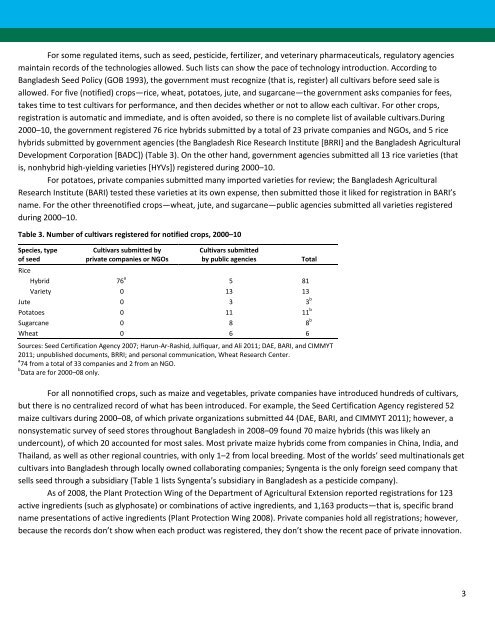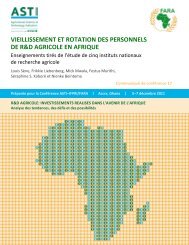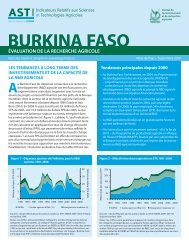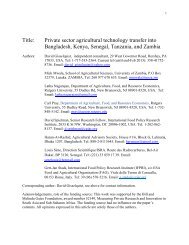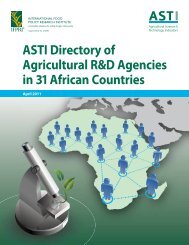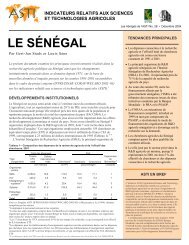Bangladesh country report - ASTI - cgiar
Bangladesh country report - ASTI - cgiar
Bangladesh country report - ASTI - cgiar
Create successful ePaper yourself
Turn your PDF publications into a flip-book with our unique Google optimized e-Paper software.
For some regulated items, such as seed, pesticide, fertilizer, and veterinary pharmaceuticals, regulatory agencies<br />
maintain records of the technologies allowed. Such lists can show the pace of technology introduction. According to<br />
<strong>Bangladesh</strong> Seed Policy (GOB 1993), the government must recognize (that is, register) all cultivars before seed sale is<br />
allowed. For five (notified) crops—rice, wheat, potatoes, jute, and sugarcane—the government asks companies for fees,<br />
takes time to test cultivars for performance, and then decides whether or not to allow each cultivar. For other crops,<br />
registration is automatic and immediate, and is often avoided, so there is no complete list of available cultivars.During<br />
2000–10, the government registered 76 rice hybrids submitted by a total of 23 private companies and NGOs, and 5 rice<br />
hybrids submitted by government agencies (the <strong>Bangladesh</strong> Rice Research Institute [BRRI] and the <strong>Bangladesh</strong> Agricultural<br />
Development Corporation [BADC]) (Table 3). On the other hand, government agencies submitted all 13 rice varieties (that<br />
is, nonhybrid high-yielding varieties [HYVs]) registered during 2000–10.<br />
For potatoes, private companies submitted many imported varieties for review; the <strong>Bangladesh</strong> Agricultural<br />
Research Institute (BARI) tested these varieties at its own expense, then submitted those it liked for registration in BARI’s<br />
name. For the other threenotified crops—wheat, jute, and sugarcane—public agencies submitted all varieties registered<br />
during 2000–10.<br />
Table 3. Number of cultivars registered for notified crops, 2000–10<br />
Species, type<br />
of seed<br />
Cultivars submitted by<br />
private companies or NGOs<br />
Cultivars submitted<br />
by public agencies<br />
Rice<br />
Hybrid 76 a 5 81<br />
Variety 0 13 13<br />
Jute 0 3 3 b<br />
Potatoes 0 11 11 b<br />
Sugarcane 0 8 8 b<br />
Wheat 0 6 6<br />
Sources: Seed Certification Agency 2007; Harun-Ar-Rashid, Julfiquar, and Ali 2011; DAE, BARI, and CIMMYT<br />
2011; unpublished documents, BRRI; and personal communication, Wheat Research Center.<br />
a 74 from a total of 33 companies and 2 from an NGO.<br />
b Data are for 2000–08 only.<br />
Total<br />
For all nonnotified crops, such as maize and vegetables, private companies have introduced hundreds of cultivars,<br />
but there is no centralized record of what has been introduced. For example, the Seed Certification Agency registered 52<br />
maize cultivars during 2000–08, of which private organizations submitted 44 (DAE, BARI, and CIMMYT 2011); however, a<br />
nonsystematic survey of seed stores throughout <strong>Bangladesh</strong> in 2008–09 found 70 maize hybrids (this was likely an<br />
undercount), of which 20 accounted for most sales. Most private maize hybrids come from companies in China, India, and<br />
Thailand, as well as other regional countries, with only 1–2 from local breeding. Most of the worlds’ seed multinationals get<br />
cultivars into <strong>Bangladesh</strong> through locally owned collaborating companies; Syngenta is the only foreign seed company that<br />
sells seed through a subsidiary (Table 1 lists Syngenta’s subsidiary in <strong>Bangladesh</strong> as a pesticide company).<br />
As of 2008, the Plant Protection Wing of the Department of Agricultural Extension <strong>report</strong>ed registrations for 123<br />
active ingredients (such as glyphosate) or combinations of active ingredients, and 1,163 products—that is, specific brand<br />
name presentations of active ingredients (Plant Protection Wing 2008). Private companies hold all registrations; however,<br />
because the records don’t show when each product was registered, they don’t show the recent pace of private innovation.<br />
3


